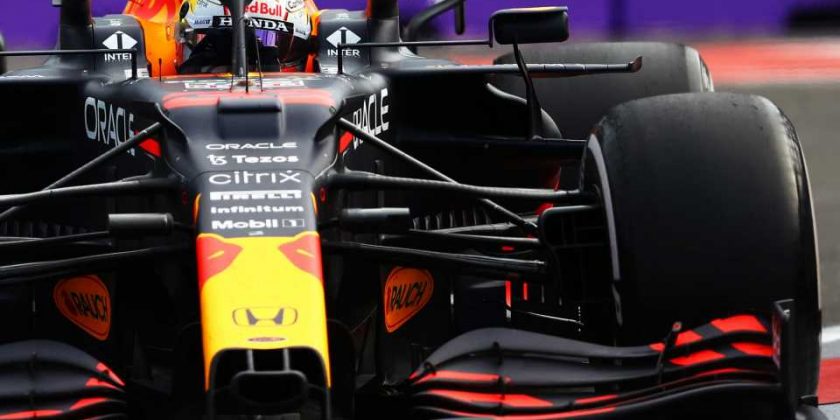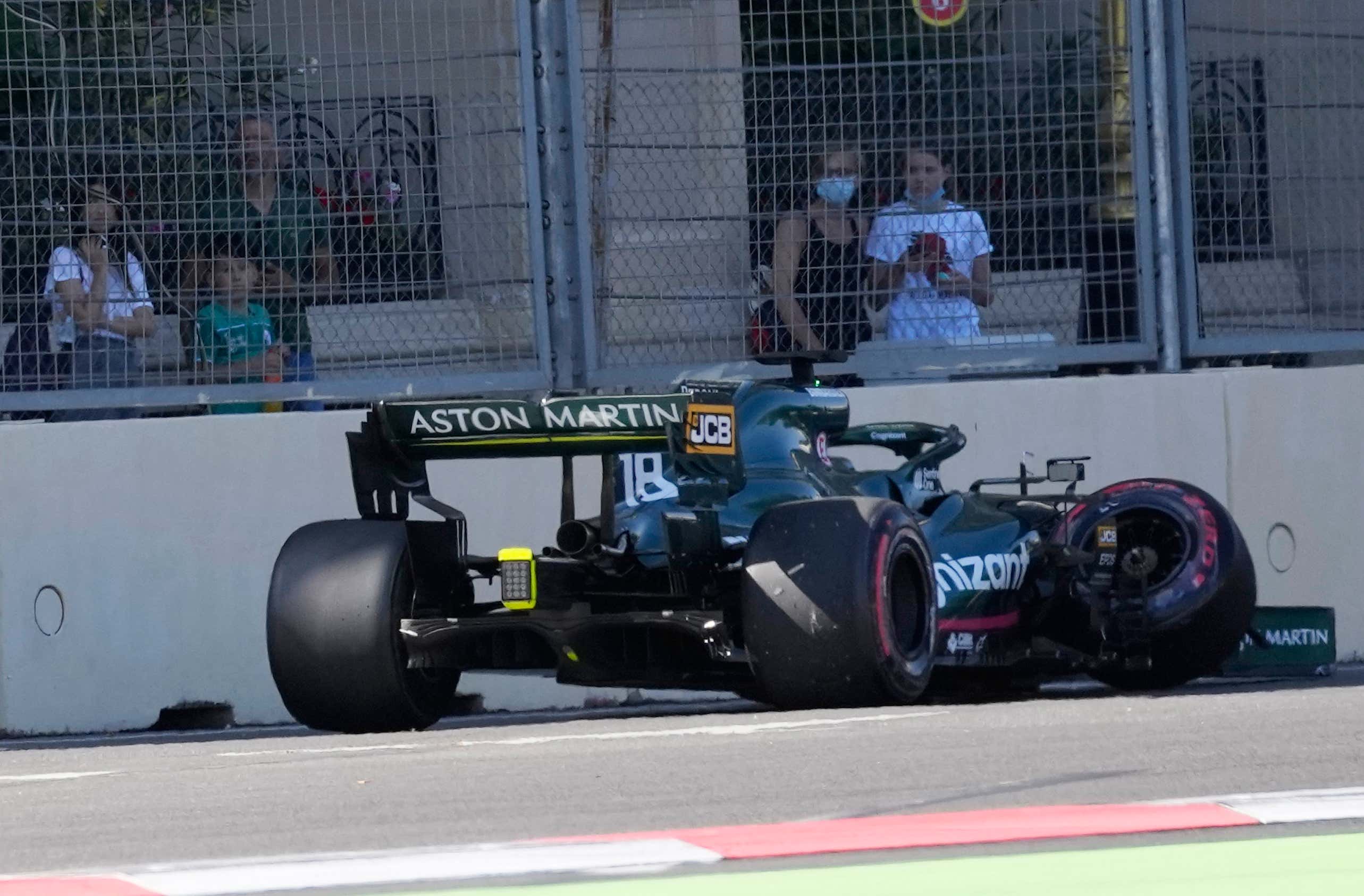Much like my Tinder inbox, red flags are expected at Baku. It’s a tight street circuit that, unlike Monaco, is ludicrously high-speed and a small error can turn into a big smash.
As F1’s sole tire supplier, Pirelli has faced criticism for the tires it’s provided in the past. In 2020, Lewis Hamilton won the British Grand Prix on three wheels after a tire fell apart on the final lap, and Max Verstappen retired when his tire blew halfway through the race at Imola. In 2021, drivers weren’t happy with the compounds after testing either. Hamilton went on saying these were “three kilos heavier and a second a lap worse,” and it’s safe to say their concerns won’t be downplayed after Sunday’s Azerbaijan Grand Prix.
Baku’s pit straight is one of the fastest sections of track across the F1 calendar. And it’s one that Nico Rosberg, who won the race in 2016 (then somewhat disingenuously called the “European” grand prix), flagged in his track guide as really, really dangerous.
Talking about the area immediately before the pit entrance, Rosberg said, “Imagine something breaks on the car here, you’re at 350kph (217 mph) and on the left there, just four meters to your left, there’s a wall and it’s facing you. So if something breaks here, it’s the end, there’s no more you.”
“So it’s one of the most scary places that I’ve ever driven an F1 car in. To go by there just feels ridiculously wrong. But anyway, you have to try and blend it out and keep going.”
Two drivers who absolutely couldn’t do that in yesterday’s race were Lance Stroll and Max Verstappen. Both suffered catastrophic tire failures coming onto the pit straight and crashed heavily, fortunately, both hitting other barriers before they reached that pit entry wall.
Although Stroll described it on his post-crash radio message as “a puncture,” footage afterward showed the Pirelli had eroded through its inner sidewall. The carcass seemed to have completely split along the tire’s shoulder, despite belts looking like they were still holding on the inside.
At the time Stroll, who had started on hard compound tires, had done the longest stint on them of any driver. Although, before the race, Pirelli had said they had an expected stint life of at least 40 laps, it looked as though the Aston Martin car had suffered the failure on just its 30th lap around Baku.
It was a little bit odd, considering they’re very different tracks, that Pirelli had brought the exact same kinds of tires to Baku as Monaco. Monaco is low power, low speed and the shortest lap on the F1 calendar. Baku is high power, high speed and one of the longest circuits, with an enormous, 1.5-mile straight—the one both crashes occurred on.
In 2019, Pirelli brought tires a step harder to this track, but for 2021 it was the C5, C4 and C3 compounds—the softest available for any race. And softer tires, especially with high speeds and big loads being put through them, last less distance than harder tires, so when you see Stroll’s blowout it’s easy to think Pirelli’s stint prediction was calculated.
Another quirk of the situation was that Stroll’s crash was kind of over the pit entrance, so the pit lane was closed for the majority of the safety car period while it was retrieved. That meant drivers couldn’t get fresh rubber—apart from a few towards the back of the grid, who managed to make the most of a slim opportunity at the end of the safety car and were left carrying on on the same compound they’d just seen basically explode.
Teams believed they were managing the tires well, however. By lap 46 F1’s opinion-dividing AWS analytic graphics said that Sergio Perez, at the time running in second and defending against Hamilton, was down to 10 percent of whatever that stat analyses on his rear tires.
Lando Norris said he felt vibrations, which maybe wasn’t surprising, seeing as by that point he’d done 37 laps on the hard compound, seven more than Stroll had before they decided they weren’t up for another lap.
It wasn’t Norris’ tires that went, however. Max Verstappen, leading the race, basically replicated Stroll’s incident.
Once again out of the final corner, on that extremely high-speed part of the track, his left rear gave up and sent Verstappen’s car flying into concrete barriers. Fortunately, neither driver was harmed in the high-G-force incidents, although Verstappen’s was so vicious he had to go for mandatory medical checks.
The Red Bull pit wall radioed race control after a safety car had been called, telling F1’s race director, Michael Masi, that the race needed to be red-flagged because they’d had no warning that Verstappen’s tires would blow.
The message from Jonathan Wheatley (Red Bull’s sporting director,) which was played out on the F1 broadcast: “Michael I know you’re busy but we got zero warning on that failure, nothing on a metric, not a vibration. Our point is: consider red flag and the opportunity for everyone to change tires.”
It’s possible the team had an ulterior motive in then pushing for a red flag, as Sergio Perez revealed after the race that his car was on the brink of failure but it would also be legitimate to city safety concerns, if there was a risk multiple cars could suffer the same issue at the same time in the race’s final laps.
Either way, the red flag was called. Everyone switched onto the soft tire for a two-lap showdown on the restart. We’ll never know what might have been. But what’s weird is that Stroll’s tire blew as he was about to start his 30th lap, Verstappen’s as he went on to his 35th.
By the time cars pitted, Norris and Fernando Alonso had done 41 laps on their hard tires. Multiple other drivers had done over 37 laps of distance on theirs, so it wasn’t like wear could be the only cause of what happened to Stroll and Verstappen. And it’s strange that the incidents were in such a similar place.
One possible explanation, indeed, very much the one Pirelli is going with, is that both cars ran over debris. It’s possible, of course, that Stroll found something to run over, and then Verstappen did the same. Although there’s nothing obviously visible on the onboard shots, it’s hard to tell if there’s some micro-shard of carbon fiber.
Pirelli has defended itself by saying that Hamilton, who made it to the end of the race but not with much dignity, also had a substantial cut in his tire.
Thing is, that could’ve been caused by anything. And by the time Hamilton’s tire had been switched, he’d run through Verstappen’s debris and the pit lane at least once on it, under the safety car.
On the standing restart, trying to take the lead from Sergio Perez, Hamilton accidentally re-activated a brake mode intended for warming. Essentially disabling the rear brakes, it sent him off-track at turn one and he finished dead last, behind both Haas cars. Runoff areas, of course, do tend to be where debris ends up.
The good news is we might never need to worry about this again. Or well, not for a bit. The only other tracks that are due to use the softest compounds are Sochi and Abu Dhabi.
Sochi is a high-speed quasi-street circuit where drivers have a tendency to out-brake themselves already avoiding barriers. Abu Dhabi is the only circuit that can compete with Baku in terms of the number of 90-degree corners, and again, has pretty high-power sections. Both of them usually have high track temperatures due to local weather.
Pirelli hasn’t given a final verdict on what happened yet, taking the tires back for testing so we won’t know the official line until later. Like any other time this has happened, it’ll say the tires were damaged by some kind of invisible debris that the teams couldn’t detect until it was too late.
Whether cars should be rocketing around at 200 mph on tires where, with all the vast array of sensors they have live telemetry from, it’s not possible to tell that one of them is gonna check out of Sunday completely, is a pretty crucial question. Pirelli gets very little time testing new tires, even less for the 2021 tires due to the COVID-19, and in its defense, it generally tries to provide as much information as it can to teams.
Working to strict budget restrictions, teams are not keen to have massive crashes. Points and podiums aside, Aston Martin and Red Bull now need to completely repair their cars, including possible chassis changes. The last truly massively destructive crash, when George Russell and Valtteri Bottas collided in Imola, allegedly cost Mercedes upwards of $1 million and forced them to re-budget for in-season upgrades to their car. Not to mention Bottas’ car really hasn’t worked the same since.
As a consequence, the teams will be keen to indict Pirelli in the hope they can claw some compensation or a budget dispensation out of it. So get ready for some Netflix-worthy action going across the paddock when F1 reconvenes in Paul Ricard in a fortnight.
At least we can all agree: Well done, Baku.
Got a story tip? Email me at [email protected]
RELATED
F1 Might Add a Second US Race This Year
With the Singapore Grand Prix apparently canceled again, COTA might be tapped for double duty.READ NOW
RELATED
Why F1's Top Two Drivers Don’t Do Track Walks
Hamilton called them a "pointless exercise" while Verstappen says he "can't be arsed" with them. Why is that?READ NOW
RELATED
Aston Martin Celebrates LGBTQ+ Community By Putting Pride On Its F1 Cars
Representation can be hard to find in motorsport, and this is going prime time.READ NOW
RELATED
Mercedes Has Finally Unstuck the Nut From Bottas' F1 Car
The stuck nut was a humbling blow for the dominant F1 team, but they're finally ready to move on.READ NOW
RELATED
F1 Driver Kimi Raikkonen, the 'Iceman,' Appropriately Calls His Kids the 'Ice Cubes'
If you've got a cool nickname, embrace it.READ NOW
Source: Read Full Article

